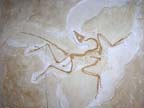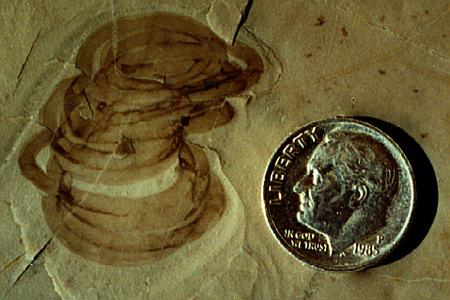 |
 |
 |
 |
 |
Produced
by the Population Genetics and Evolution class, Furman University |
||||
 |
 |
 |
 |
 |
Produced
by the Population Genetics and Evolution class, Furman University |
||||
 |
The
Precambrian: Grypania spiralis |
 |
Grypania spiralis is considered to be an early eukaryotic alga or giant bacterium, whose fossils date back 2 billion years to the Precambrian eon and are the rarest fossils on earth. (Fossil Pictures). Grypania spiralis are described as two dimensional ribbon like coils found fossilized as “bedding plane compressions, carbonaceous films, or faint colorations” (Major Events in the History of Life) and can reach a length of approximately a half meter. They are found fossilized in slates from the U.S., India and China (Henderson, 2009). Some scientists, but not all, consider it to be the oldest known eukaryotic/multicellular organism, which is astonishing because all other specimens in the Precambrian eon are all prokaryotes (Fossil Pictures). Furthermore, Grypania spiralis is over 1 billion years older than the next known eukaryote (Fossil Pictures), which raises further speculation against the suggestion that it is an eukaryotic species. Grypania spiralis fossils are examined using reflected-light microscopy and scientists have found no “cell wall ultra structure” or “a definitive multicultural construct” that would suggest an eukaryotic species. (Major Events in the History of Life). Because the development of eukaryotic life is paramount to life as we know it today, further research on Grypania spiralis is key to understanding our origins. Page by Matt Medlin |
  |
| Photo credit:Fossil Pictures and Major Events in the History of Life. | |
| Fossil
Pictures. Accessed 1/18/2010.
Henderson, M. 2009. Morphological and geochemical investigation of Grypania Spiralis: A new look at an old fossil. Geological Society of America Abstracts with Programs, 41: 629. Major Events in the History of Life. . Accessed 1/18/2010. |